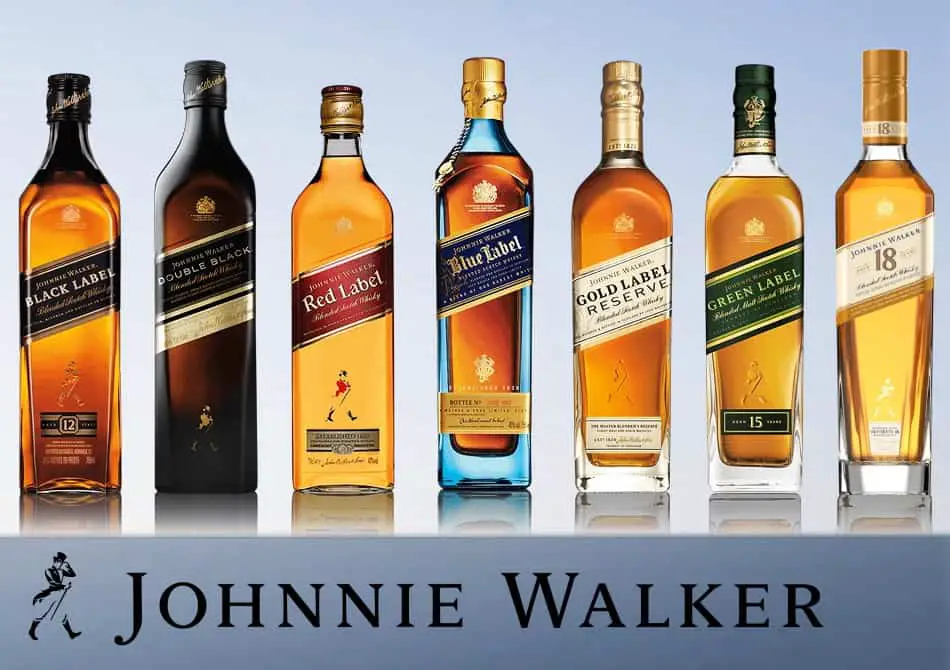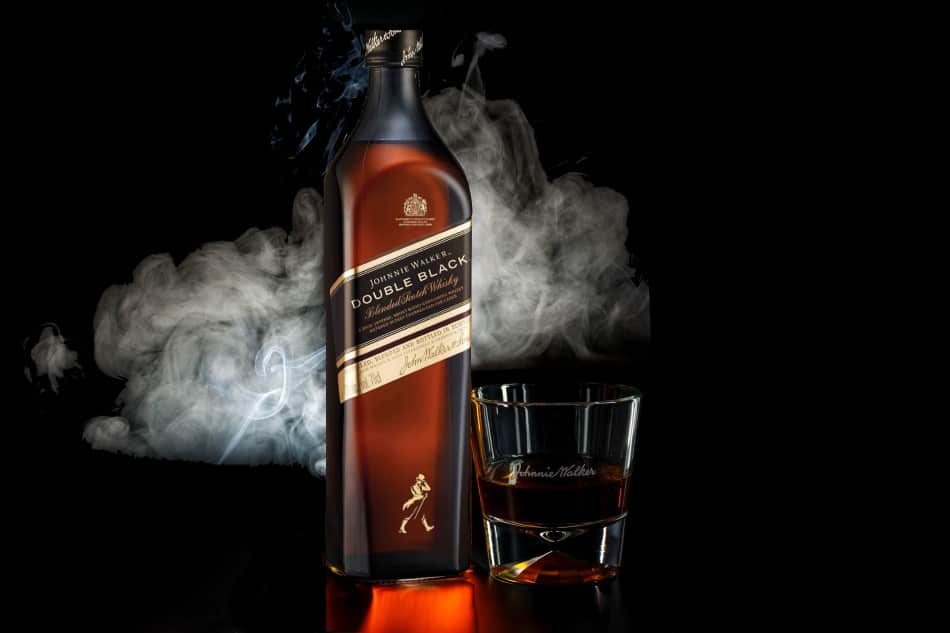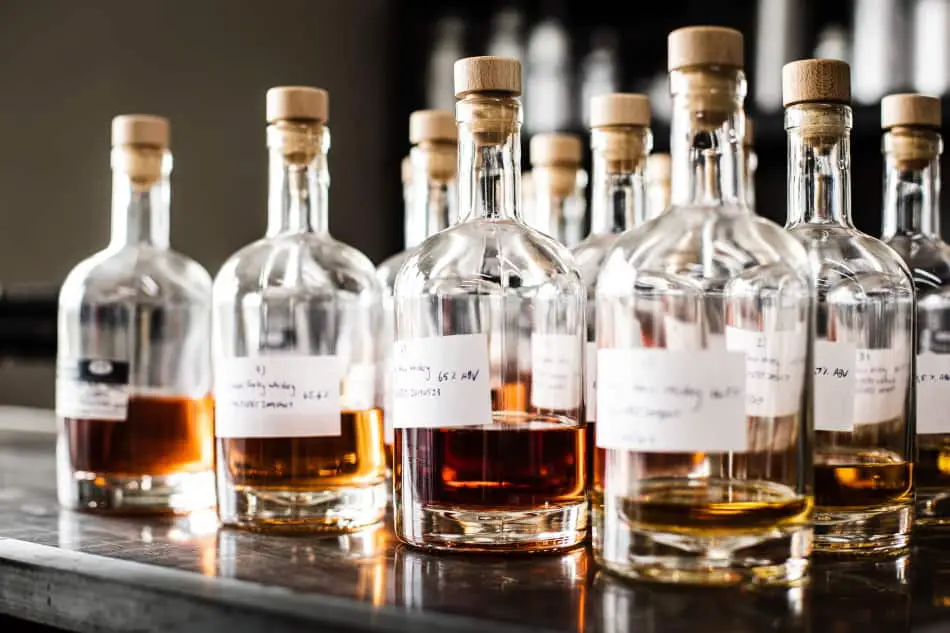It can be difficult to explain exactly how Johnnie Walker whiskies are made. That’s because Johnnie Walker is not a distillery that makes its own whiskies but a brand that blends different types of whiskies, from different distilleries, from all over Scotland to make their own expressions.
This means that in order to know how Johnnie Walker whiskies are made you need to know how all types of Scotch whiskies are made. And how Johnnie Walker blends them together. But don’t worry I’ve broken it down into six easy steps.

1. Malting Or Cooking Grain to Access Its Starches
The first step in making each of the individual whiskies that will eventually be combined with several others to make up one of the Johnnie Walker expressions, is to malt or cook the grain or grains it’s made from. This is done in order to make the starches in the grains accessible as malting or cooking breaks down the cellulose walls that contain the starch granules. Now the starches are ready to be converted into soluble sugars and then alcohol in the next two stages.
Whether the grains are malted or cooked will depend on the type of whisky being made – malt or grain whisky. The difference between the two in terms of grain is:
- Malt whiskies from Scotland must be made from malted barley only.
- Grain whiskies from Scotland are made from any other grain or grains – usually corn, rye or wheat.
Accessing the starches in all grains apart from barley is done by grinding them down into meal and cooking them with water. Accessing the starches in barley is done by malting them. And then grinding them down into meal.
Malting barley is done by soaking the grains in warm water and then spreading them out on the floor of the malting house where they’re left for about five days to partially sprout or germinate. The germination process is stopped by spreading the barley on the grids of a kiln to dry with hot air from below.
How the malted barley is dried will also depend on the type of (malt) whisky being made – whether it’s peated or unpeated. A peated whisky is one in which peat was used to fuel the kiln that dried the malted barley. The peat fire releases smoky flavor compounds which goes into the grain and gives the whisky a peaty, smoky flavor.
Of course, different whiskies are dried in the peat smoke for different amounts of time, which is why you have different types of peated whisky – anything from lightly peated whiskies all the way to whiskies that are peat monsters.
The Johnnie Walker expressions include peated whiskies in their blends. Four that we know of are whiskies from Cardhu, Clynelish, Coal Ila and Glenkinchie. Glenkinchie whiskies are only gently peated, and Cardhu and Clynelish whiskies are peatier but still not that peaty. Coal Ila is an Islay whisky which are known for being the most pungent and peaty of all Scotch whiskies, but it’s clearly an exception because it’s also not super peaty.
Either way, whatever goes into the Johnnie Walker blends, they end up being only lightly peaty and smoky. Even the Double Black that’s made from whiskies with a naturally smoky flavor and matured in deep charred barrels to give it a smokier flavor, is not very smoky when compared to other smoky whiskies.

2. Mashing – Converting the Starches into Sugars
The malted barley or cooked grain is mixed with warm water in a large vessel called a mash tun or tub and stirred to convert the now accessible starches in the grain into sugars. After a few hours the mixture becomes a thick porridge-like, sugar-rich liquid known as mash.
When making malt whisky the sugars in the malt dissolve and are drawn off through the bottom of the mash tun. The resulting liquid is called wort. This is done three times and the water temperature is increased each time to extract the maximum amount of sugar. Only wort from the first two times is used.
3. Fermentation – Converting Sugars into Alcohol
The wort if making malt whisky or mash if making grain whisky is cooled and pumped into large tanks called washbacks. Yeast is added so the mixture can ferment. It takes 48-96 hours for the yeast to turn the sugars into alcohol and some distilleries let it go on for longer.
The resulting liquid is called distiller’s beer and has an ABV of 5%-10%.
4. Distillation – Creating a Spirit With 65%-95%ABV
Distillation is the process of separating different parts of a liquid by heating it until it becomes a vapor and condensing it back into liquid, taking advantage of the fact that different substances have different boiling points. Alcohol boils at a lower temperature than water, so in making whisky distillation separates the alcohol from the rest of the liquid and then concentrates it, condenses it and collects it.
Malt whisky is distilled in pot stills, but grain whisky is distilled in column or continuous stills.
- A pot still has a bowl shape at the bottom and a narrow neck at the top and distills alcohol in batches.
- A column or continuous still has the shape of a column and distills alcohol continuously.
Column stills create a very pure distillate which means it loses much if not all of its flavor. Pot stills, on the other hand, create a distillate with more congeners (flavor compounds) and therefore, more flavors. Pot stills come in all sorts of shapes and sizes which affects the distillation, and the congeners and therefore the whisky’s flavor.
So already there are lots of different types of whiskies in terms of flavor, for Johnnie Walker to choose from when making their blends.
5. Aging / Maturing the Whisky in Barrels
The distillate is placed into barrels so that it can pick up flavors from the wood. Some estimate that during barrel maturation a whisky picks up 70% or more of its flavor. This happens because changes in temperature causes the barrels to expand and contract and the liquid to seep in and out of the wood – and pick up flavors in the process.
Of course, various factors in the aging / maturation process will affect the flavor of the whisky. The three most important ones are:
- The type of barrel used
- The length of time the whisky is aged
- The storage environment
Legally, all Scotch whisky must be aged in used oak barrels for at least three years but that still leaves plenty of room for flavor-affecting variations. Different barrels will have different flavors for the whisky to pick up. This depends on things like the type of oak wood it’s made from, whether it was toasted or charred, how old it is and the spirit it was previously used to age.
The length of time a whisky is aged will also affect the final flavor because the longer a whisky is matured, the more times it can seep in and out of the wood and the more flavors it can pick up. Which is why single malts are often aged for 12, 15, or 18 years. Or 21, 25, or 30 years. Or longer.
The storage environment also leaves a lot of room for flavor-affecting variations. Johnnie Walker uses whiskies from all over Scotland in its expressions and although it’s not a large country it is big enough to have different natural environments. That’s why there are five Scotch whisky regions each known for producing whiskies with very different characteristics as shown in the table below.
| Characteristics | |
|---|---|
| Scotch from Lowlands | Light bodied, delicate, soft, smooth, very little peat. They’re malty and citrusy with flavors of grass, honeysuckle, cream, ginger, toffee, toast and cinnamon |
| Scotch from Highlands | There are full bodied and spicy whiskies, lighter and fruity whiskies and those that are full bodied, peaty with a salty tang from the sea |
| Scotch from Speyside | Both light and bold whiskies that are sweet, fruity and spicy with hints of apple, nutmeg, vanilla and smoke |
| Scotch from Campbeltown | Fruity, peaty, sweet and smoky. There will be notes of sea salt and a briny taste along with vanilla and toffee flavors |
| Scotch from Islay | Peaty, smoky, earthy and oily with a hint of salty sea air, brine and seaweed |
This really gives Johnnie Walker lots of flavors to choose from when making their blends.
6. Blending Whiskies to Create Their Own Flavors

Since Johnnie Walker makes blended Scotches, before we get into this stage of the whisky making process, we need some definitions:
- A single malt Scotch is a malt whisky made at a single distillery.
- A single grain Scotch is a grain whisky made at a single distillery.
- A blended malt Scotch is a combination of two or more single malt whiskies from different distilleries.
- A blended Scotch is a combination of one or more single malt whiskies with one or more single grain whiskies.
As mentioned, Johnnie Walker is a blend of all types of whiskies, from all types of distilleries, from all over Scotland. That means as we’ve seen, malt whiskies, grain whiskies, lighter whiskies, bold whiskies, sweet whiskies, fruity whiskies, spicy whiskies, peaty and smoky whiskies. It’s a good job that Johnnie walker and its parent company own several distilleries between them.
Johnnie Walker’s master blender selects whiskies from among all those that are available and then blends them in precise formulaic proportions, to produce expressions that have the specific characteristics and flavors chosen by the brand.
Obviously, different expressions are blended differently and have different characteristics and flavors. Here are the details of the seven main Johnnie Walker blends that make up its core range:
Johnnie Walker Black Label 12 Years
This is a blend of up to 40 single malt and grain whiskies from across Scotland, each of which have been aged for at least 12 years.
Notice that both numbers are not definitive. That’s because when Johnnie Walker blends their expressions, they only have to make sure the taste is consistent and not anything else. Different batches of Black Label could contain a different number of whiskies that could be of different ages and while none of them can be younger than the stated 12 years, some of them might be significantly older.
Johnnie Walker Double Black
Similar to the Black Label, Johnnie Walker Double Black is also a blend of both malt and grains whiskies, but it has no age statement so it’s much younger – although all the whiskies must be at least three years old. This is why the Double Black is known as the younger sibling of the Black Label.
The difference between the two is that the whiskies selected for the Double Black have a naturally smoky flavor and were matured in deep charred (hence the name) barrels to give the final expression a smokier flavor.
Johnnie Walker Red Label
This is a blend of up to 30 single malt and grain whiskies with no age statement. It’s intended for mixing as opposed to drinking neat which is a good job as some find that it’s dominated by the young grain whisky in its blend.
Johnnie Walker Blue Label
This is a blend of the best and most flavorful whiskies available to the brand. It has lots of delicious flavors and is very very smooth.
Johnnie Walker Gold Label Reserve
This expression contains 15 different whiskies but is built around a single malt from Clynelish.
Johnnie Walker Green Label 15 Years
This is the only blended malt whisky made by Johnnie Walker, meaning it doesn’t contain any grain whisky. All the whiskies in the blend have been aged for at least 15 years.
Johnnie Walker Aged 18 Years
This is a blend of malt and grain whiskies that have been aged for at least 18 years.
And that’s how Johnnie Walker whiskies are made. For a full review of them see the article I wrote about it here. You can buy any of their expressions at drizly.com here .
.
